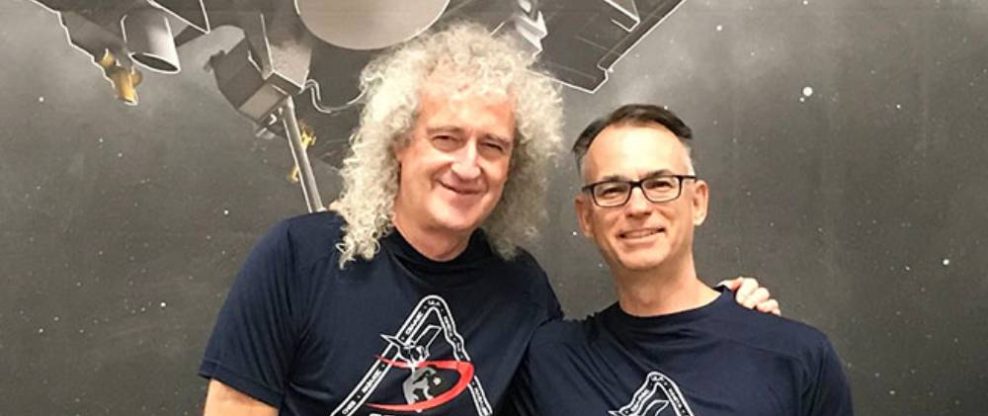TUCSON, AZ (CelebrityAccess) – Arizona’s top principal investigator (PI) on NASA’s asteroid sampling mission has teamed up with a highly respected member of rock royalty to write a book on Bennu.
Bennu 3-D: Anatomy of an Asteroid uses data from the University of Arizona (UA) led OSIRIS-REx mission to create what is being described as the world’s first complete atlas of an asteroid, reported Tucson.com.
The book was co-authorized by US professor and OSIRIS-REx PI Dante Lauretta and Brian May, a Ph.D. astrophysicist – also known for his other job as lead guitariat and co-founding member of the legendary rock band Queen.
In Lauretta’s preface to the book, he recalls first meeting the rock star through a mutual friend in the space science world in 2016, a few months before OSIRIS-REx was launched.
“Brian and I corresponded briefly about the mission and my hometown of Tucson, Arizona, where he had spent some time enjoying the natural beauty of the Sonoran Desert and using it for self-reflection, as many do,” he writes.
They met in person in 2017 when May invited Lauretta and his family to join him backstage at a concert in Phoenix. The two kept in regular contact after that.
“As the OSIRIS-REx mission progressed, I couldn’t help but share some of the latest developments with him,” Lauretta writes. “To my delight, Brian showed a keen interest in the mission and the science behind it. It was clear that he was not just a casual fan, but a true space enthusiast and an advocate for space exploration.”
May and his collaborator, Claudia Manzoni, used publicly available data collected by the spacecraft to produce stereoscopic images that showed Bennu’s rugged and dangerous landscape in what Lauretta describes as “glorious 3-D.”
Producer Dan Gallagher and data visualizer Kel Elkins discuss the making of a video called “Tour of Asteroid Bennu” and how data-driven animation is enabling viewers to explore new worlds. (above)
Lauretta soon offered May and Manzoni formal positions on the OSIRIS-REx science team, with full access to all the mission’s data.
There was nothing casual or honorary about the invitation. “OSIRIS-REx is serious business,” Lauretta writes, “and I was not interested in tourists joining the team simply because they were celebrities.”
May and Manzoni would go on to produce countless stereo images of Bennu’s terrain that helped the team identify small craters filled with fine-grain material for the spacecraft to safely sample, which it famously did October 2020.
The new book highlights 80 of those images, including some that are being published for the first time. It comes with a pair of May-designed Lite Owl stereoscopic viewers to see the pictures as they were intended to be seen.
Bennu 3-D is co-published by The University of Arizona Press and May’s London Stereoscopic Company. Fellow co-authors include Manzoni, imaging engineer Carina Bennett, planetary geologist Ken Coles and science editor Cat Wolner.
The book is set for release on Thursday (July 27). In celebration of the release, The Natural History Museum (NHM), May, Lauretta, and Professor Sara Russell (NHM) are hosting a virtual talk on July 31. You can pre-order the book and find details on the virtual talk HERE.
May said via his official website, “It’s only recently we have begun to understand the enormous significance of asteroids in the fortunes of Planet Earth. It’s long been recognised that some of them have the power to destroy our planet by collision. But it’s now becoming evident that previous asteroid (and cometary) impacts supplied ALL the material from which our entire Biosphere is made – and as such are responsible for our very existence. This, together with the possible benefits to humanity from mining asteroids for minerals, gives us three vital reasons for making close studies of near-Earth asteroids. The OSIRIS-REx mission undertook by far the most intimate exploration of any asteroid to date, and here are the results, the fruits of the labours of a huge team of top scientists and engineers. Our aim has been to deliver this extraordinary portrait in a form which is understandable and enjoyable to scientists and non-scientists alike.”
May studied physics and mathematics in his 20’s, but his doctoral work was interrupted in 1974 by the growing success of the band he started with singer Freddie Mercury and drummer Roger Taylor four years earlier.
May returned to his doctoral work in 2006 to finish his Ph.D. thesis on bands of interplanetary dust known as the zodiacal cloud. The newly minted doctor of astrophysics would go on to help found a global awareness campaign called Asteroid Day, author several books, and serve as a science team collaborator on NASA’s New Horizons spacecraft as it flew past Pluto.
Since then, he has produced 3D stereo images of solar system objects using data from New Horizons, OSIRIS-REx and the Japanese space agency’s Hayabusa2 asteroid sampling probe.
Lauretta is a professor of planetary science and cosmochemistry at UA’s Lunar and Planetary Laboratory.





























